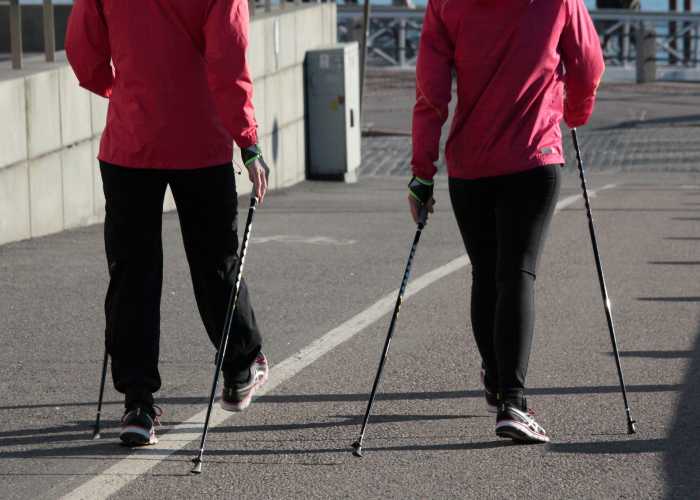
Moccasin Guru - Is Walking A Good Exercise?
Posted on 5 August, 2020

Image by Mabel Amber from Pixabay
Written by for Moccasin Guru
Walking is great. It helps you clear your head, it keeps you active and it’s low-impact and joint-friendly. But is walking a good exercise? The short answer is yes, but like all things there is a skill to it. So read on if you would like to find out more about the intricacies of walking!
Walking is your body’s natural movement. To count as exercise, you should aim to walk at a brisk pace for about 30 minutes, at least four times a week. Pay attention to your posture and footwear choices, and always warm up and cool down after your walks.
I’ll go through some of the benefits of including walks into your daily routine. You’ll also need some pointers on the kinds of shoes you should wear on your walks. On top of running, you can also add some other exercises to help increase your heart rate and burn calories.
Benefits Of Walking
While many people wouldn’t don’t consider walking as exercise, it certainly benefits you in many ways, both physically and mentally.
Physical Condition
Walking at a moderate intensity for at least 30 minutes, five times a week is the minimum recommended amount of exercise. In particular, walking a longer distance at a faster pace will provide even more benefits.
People who walk regularly were found in a study to have a 31 percent decrease in their risk for cardiovascular diseases.
Other benefits include:
- The stress release from walking will help you sleep better.
- Your overall health will improve as you lower your blood pressure and cholesterol.
- Like any exercise, it helps you maintain muscle tone and bone density.
Walking will also help you burn some calories. Depending on your age and weight, a brisk 30-minute walk can help you burn an average of 129 more calories a day. If you’re also following a healthy diet, this can add up in the long run and help you lose weight.
Mental Wellbeing
If you take your walks as a moment to get in contact with yourself, you’ll get benefits that go far beyond the physical impact of the exercise. Exercise at even a moderate intensity can help reduce stress and anxiety and even improve cognitive function.
You can use walking to get an active start to your day and a moment to focus on your goals for the day. You can also take a walk at the end of the day to unwind and release stress.
How To Turn Walking Into Exercise
Walking is a natural movement of your body. It’s low-impact and meditative and helps you crank up the steps on your Fitbit. If you don’t do any exercise, starting a walking habit will certainly be an improvement for your health.
It’s also a lot easier for your joints than running, especially if you’re overweight or have underlying problems. This is what makes it a good way to get active for beginners.
But for such a low impact, is it even exercise?
Yes, if you do it correctly.
While some may consider walking an inferior form of movement, it’s a good way to burn calories and add activity. However, walking as an exercise doesn’t mean peacefully strolling around.
To be an effective exercise, walking needs to be brisk. This means you have to be a little winded and feel your heart rate going up. Your pace should be fast enough so that it would be hard for you to talk while you’re walking.
How Long Does It Take To Walk A Mile?
You should be able to walk a mile in fifteen minutes for it to count as brisk.
If you’re not able to do this at first, take your time and work on increasing your speed. Give yourself a goal to get a minute or 30 seconds out of your mile every time you go out. You’ll get to a 15-minute mile in no time.
Good Walking Form
The right form and speed are the most important things to get the biggest benefit out of your walks.
Warm up your muscles at a slower pace before starting and cool down after you’ve finished. Always stretch after your walks to maintain and increase your mobility.
- Back: Keep your back straight, your shoulders back and your head high—that means no looking at your phone!
- Shoulders: Try to relax your shoulders and keep your arms slightly bent and swinging freely.
- Breathing: Focus on your breathing correctly, taking profound inhales.
- Feet: Try to walk as neutrally as possible, with your toes pointing forward. Land on the heel at first and then let your weight move naturally toward your toes.
- Engage: Keep your core and your legs and glutes engaged.
Walking Equipment
Walking for exercise doesn’t require much equipment to be effective, but you may need to pay attention to your clothes and shoes. You can also invest in some poles to try out Nordic walking.
Comfortable Clothes
Make sure you’re wearing comfortable clothes that don’t inhibit your movement or cause other types of discomfort. Your regular workout clothes will be fine, as long as they’re stretchy and don’t have seams that will make you chafe.
Rather than wearing your regular comfy clothes, go for specific lightweight activewear. These offer protection from the elements while keeping you warm and will wick moisture away.
A Good Pair Of Shoes
Walking is free, but you might want to invest in the most basic piece of equipment before you get started: shoes. The right shoes are the most important thing to take into consideration when you’re starting a walking hobby.
The first thing is to wear shoes that are made for exercise and are comfortable. They need to have enough support and cushioning to help you get through many miles of walking without injury.
Running Shoes Vs. Walking Shoes
Running shoes aren’t your best bet for walking practice. The two patterns of movement impact your foot differently, so you should give your foot the support it needs for the specific movement.
Running will impact your heels more as they’re the first point of contact with the ground. Walking puts more pressure on the middle of your foot. That’s why running shoes have more cushioning in the heel, whereas walking shoes usually focus more on arch support.
Finding Your Perfect Shoe
Depending on your previous underlying conditions, you might need to find a shoe that adapts specifically for them.
For example, people with flat feet need a little more support for the arch. If your arches are very high, you may need to balance them out to correct the alignment. This will help keep your ankles, knees and hips safe from unnecessary strain.
If you have plantar fasciitis, you may need more cushioning in the heel to keep it slightly elevated.
Spend some time figuring out whether you have flat or high arches or if your gait is neutral or if you tend to pronate. Then, make sure you’re wearing shoes that are right for you.
Nordic Walking Poles

Nordic walking can be helpful for people who are rehabilitating from injury. It can give some assistance in your upper body movement when walking and prevent your shoulders from curving forward. This is especially important for older adults.
Nordic walking also helps you burn more calories since it gets your whole body moving. You’ll be using 80–90 percent of your muscles by engaging the upper body instead of 50 with normal walking. This helps you burn up to 67 percent more calories every time you work out.
When you start with Nordic walking, make sure you’re using the right technique:
- The poles should be kept low, instead of ahead of your body.
- You should slightly swing your arms forward and back.
Walking For Weight Loss
Walking can be very therapeutic and a great way to aid you in weight loss. Keep these pointers in mind to get the most out of your walking workouts.
Calories
The basic equation of weight loss is that the calories you ingest need to be lower than the calories you use in a day. Your calorie expenditure depends on many things, from your weight to your age and general activity level.
According to Health Department guidelines, an adult woman would need around 1,600 to 2,400 calories per day. A man would need from 2,000 to 3,000 calories a day.
You can evaluate the calories you’ve burned with exercise with many apps or online calculators. Keep in mind that these are always rough estimates according to your body weight, as people have very different metabolisms.
Also, remember that weight loss is dependent on a healthy and balanced diet. Half an hour of walking won’t help you burn through hundreds of extra calories, so make sure your diet is in check.
Difficulty
Try to challenge yourself with your pace. Increase your velocity slowly when you get more comfortable.
Another way to increase the intensity of your walk is to choose a terrain you’re not as familiar with. Walking on the beach will add some real difficulty to your workout. Hiking up a hill will also help you burn extra calories and target your leg and glute muscles more.
Intervals
Doing intervals is also very beneficial for your weight loss goals and can help you improve your aerobic capacity faster. You could end up burning 20 percent more calories by simply changing your pace.
This is also great if you’re having a hard time keeping up with a faster pace for longer periods.
Try increasing your speed for a couple of minutes at a time and then relaxing it for another minute or two. It’s good if you can add these intervals to your walks a couple of times a week to really see improvements.
Treadmill Walking
If you’re walking indoors on a treadmill, you can easily make it more intense and add to the calorie burn. You can use different speeds and adaptable inclination to make your exercise more varied and interesting.
Try starting slow and gradually increase the inclination on the treadmill to a degree you can handle for a couple of minutes. Then go back, give yourself a breath, and repeat. You can also try some intervals at a higher speed.
Keep In Mind
One important thing before you head to the treadmill, however, is not to hold onto the supports.
You’ll end up relying too much on them and even putting some of your weight on top of the handles. This will not only make the exercise less effective but will also affect your posture in the long run.
Keep your chin up and your arms swinging from side to side just like you would outdoors. If you need to grab the handles to give yourself a breath, only do it for a couple of seconds.
Curved Manual Treadmills
You might have seen the curved manual treadmills at your gym in recent years. They’re non-motorized, which means you move the treadmill with your steps. Since they’re concave, each step you take propels the movement of the treadmill.
What’s great about this device is that it significantly ups the intensity of your exercise. It helps reduce the impact on your joints, while at the same time making it harder for your muscles to keep up. You can also make it more difficult by turning on the resistance of the treadmill.
These kinds of treadmills can be a bit hard to master at first, especially with the balance. Ask a gym instructor for help, and lightly hold on to the railing until you’re sure you’re balanced.
Overall, a curve treadmill can be a nice addition to your walking routine. Try to switch it up between a normal treadmill and walking outside to avoid affecting your gait.
Other Exercises To Aid With Walking
Getting in some muscle-strengthening exercises will help you have more power in your legs and improve your endurance and speed. It will also help your general wellbeing and, if done correctly, keep you injury-free.
Another perk for building muscle is that it will help you burn more calories. While fat is more of a passive component, muscle needs calories to maintain density. This is why your body will burn more calories, even when resting when you have more muscle.
- Legs: Do basic squats or lunges to improve the strength in your legs.
- Upper body: You’ll need some strength in your shoulders to help balance out your walk and carry yourself with good form.
- Core: Doing some back and ab work will help you keep your core better engaged when you’re walking.
You can even get in exercises in the middle of your walk to get your heart rate up. Try jumping or doing squats every so often to increase the difficulty. If there are stairs somewhere in your walking route, take advantage of them in your workout.
How To Pass The Time While Walking
If being alone with your thoughts doesn’t sound appealing and you get bored easily, there are a couple of things you can do to pass the time.
Find A Friend
It can be easier to start a walking habit if you do it with someone else. Even if you walk at a pace that will make it harder for you to talk, the miles will pass faster when you’re with someone else.
You’ll also be more motivated and won’t want to let your walking buddy down, which helps for those inevitable days when you’re just not feeling up to it.
Change Your Routes
By changing your scenery, you may be able to ward off some boredom. Taking yourself outside of the city or even to a new neighborhood makes things more interesting.
Listen To Music
Try listening to your favorite music to help you relax. Focus on the music and let it guide your breathing.
Music can even help you get more intensity out of your workout. How about creating a playlist that alternates between uptempo and slower songs?
Find Podcasts And Audiobooks
If music doesn’t provide you enough distraction, try listening to a podcast or an audiobook. Today, you have an incredible amount of podcasts to choose from, in every possible topic. You can learn a new language, gain new insights on health, business or politics, or listen to comedians while you walk.
For those who struggle to find the time to read a book, try listening to them. Most bestsellers from fiction to non-fiction are now published in audio versions, so you have an amazing range to choose from.
If you’re walking on a treadmill, try not to use this time on your phone or watching shows on Netflix. You’ll keep your head down in an uncomfortable angle, and you might feel this in your neck later.
Focus On Breathing
If you’re naturally tense and need some help winding down, take a meditative approach on walking. Focus on your breath and try to clear your mind of all other thoughts. It can take some getting used to, but soon you’ll be able to disconnect and only focus on your body.
Ready, Set, Go
You’re just about ready to start your new walking habit to improve your health and overall wellbeing. You’ve got your shoes, your music and your walking buddy with you. It’s time to get outside.
A minimum of 30 minutes four times a week will help you keep your blood pressure down and improve your heart health. Adding strengthening exercises and increasing the difficulty of your walks adds to the calorie burn and your overall fitness level.
Remember to keep your pace brisk and always stretch after your walk. Pay attention to your breathing and your form. Keep your shoulders down, your chin up and your arms swinging.
Written by By for Moccasin Guru - https://moccasinguru.com/is-walking-a-good-exercise/?msID=475b87a5-0b4a-48b4-a120-6ebed5897b9c
Image by Joshua Choate from Pixabay

Tags:



